 Scouts (Cruisers, then destroyers)
Scouts (Cruisers, then destroyers) Alessandro Poerio, Cesare Rossarol, Gugliemo Pepe 1915-1937
 Huesca and Teruel (1937-1957)
Huesca and Teruel (1937-1957)WW2 Italian Destroyers
Poerio | Aquila | Mirabello | Leone | Sella | Sauro | Turbine | Navigatori | Freccia | Folgore | Maestrale | Oriani | Soldati | Medaglie d’OroWW2 Italian Torpedo Boats
Indomito | Audace | Audace(ii) | Pilo | Sirtori | La Masa | Generali | Palestro | Curtatone | Albatros | Spica | Pegaso | Ciclone | ArieteThe Alessandro Poerio class were on paper three scout cruisers (“esploratore”) built before World War I and in 1921 given their small size, the two surviving ships were reclassified as destroyers. They were capable of 30 kts and at least brought the scout capability which lacked to the Regia Marina. They served from Brindisi and with the 4th Naval Division in Venice, cross-crossing the Adriatic Sea for many missions requiring speed above all. November 16, 1918 Cesare Rossarol hit a mine while steaming to Pola. The other served in the Black Sea and the Aegean Sea. They were transferred in 1937 to Franco’s Armada as Teruel and Huesca, discarded in 1948 and 1953.
From scout cruisers to destroyers

Pepe in 1930
The previous Nino Bixio class failed to bring satisfaction in terms of speed (26.82-27.66 knots (49.67/31.83 mph)) to the Regia Marina when completed in 1914, and so the admiralty looked for lighter ships, in fact a compromise between a scout cruiser and a destroyer, but still with a powerful armament armament in order to match any encountered destroyer. This difficult specification set was daunting for any engineer, and yet, several yards competed for it. S.A.I. Gio. Ansaldo e C. won the bid and over the proposed design and started construction in 1913.
The Regia Marina desperatly wanted to equip the fleet with a sufficient number of light units for protection and interception of the enemy ships. The Poerio, as a replacement for the Bixio class was designed as a compromise solution between a light scout and a destroyer. They were closer by design to regular destroyers, but converted during construction to scouts with an increased anti-ship artillery at the expense of torpedoes, especially after post-trials modifications. After the war they were reconverted back to destroyers due to their tonnage, and the armament was reworked several times. After anti-aircraft machine guns more modern main guns were adopted.
From design point of view they proved to be excellent ships, solid and equipped with the right, reliable propulsion system. After being removed from service in the Regia Marina, they were sold to the Spanish Navy where and remained in service until the early 1950s, testifying of these qualities for ships designed back in 1912.
Design of the class
Hull and general design
Externally, these ships showcased a destroyer-like hull, with a 1/10 ratio (85 x 8m) and moderate draught. The displacement varied from 891 tonnes standard, empty, as built, and 1,131t in normal dauhght but up to 1,216t fully loaded between the fuel oil, provisions and ammunitions, combat ready. To the forecastle with cutouts for the two lower forward main guns, like on US destroyers, the long main deck was straight for a large portion, and rounded to the end. The prow was near vertical with limited flare. They had the reputation of good sea boats, stable after the removal of the extra TT banks.
As for the general silhouette, they had a two-stage bridge with open deck on top, and formast at the rear, complete with a spotting top. This was followed by the main deck, two unequal size funnels, quartedeck house and four banks in two amidship/aft pairs, later two removed and alterned banks left (see later). The aft deck was bare, with access hatches, a projector platform, the shorter mainmast, and the aft telemeter for the main artillery. The ship’s width was later extended by the fitting of sponsoned guns close to the forecastle. Anti-collision bars were attached to the stern.

All three destroyers just completed in formation, Brindisi- Coll. Fondation Ansaldo
Armour protection layout
It was light to say the least. Only information available was that as scout cruisers they adopted the minimal protection consisting of a protective deck, with slopes either side, 40 mm thick (1.7 in) but it’s not even reported by all sources.
Powerplant
Propulsion was based on two sets of Parsons turbines powered by three Yarrow boilers. Two shafts droved two three-blade propellers, 2.13 m in diameter. Total output was 24,000 hp, which combined to the destroyer-like slender hull, made them excellent steamers and reached the required top speed. This was the exact same for all three units, and they were all oil-fired ensuring these srayed relevant postwar when full transition from coal to oil was realized. On trials they all three achieved the required 32 knots but in combat, fully loaded, their operating speed was down to 27-30 knots (55,56 km/h). This was still better than the Bixios. As for range, she can achieve 2,415 miles at 13 knots, 1,200 miles at 20 knots and down to 675 miles at 27 knots, which was still good for interception, especially in the narrow adriatic.
Armament
The original armament included four Vickers Terni 102 mm (4-in) 35 caliber guns and eight De Luca 450 mm torpedo tubes (18-inches) in four twin TT banks, two either side. However amidst stability issues revealed by their sea trials, two banks were removed, but it was compensated later in 1918 by the addition of two extra by 102mm/45 and two 40mm (2 pdr QF) Vickers AA heavy machine guns. They were fitted since the beginning with rails to carry and lay mines, with 21 on either side.
Main
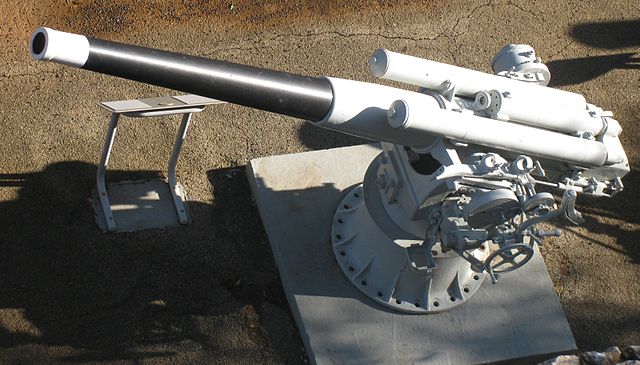
Vickers Terni 102 mm/35
The initial armament comprised four Vickers Terni 102 mm (4-in)/35. Like USN destroyers, they were placed in a lozenge pattern, one at the bow, axial, one at the stern, axial, and two either side of the forecastle cut. Later in 1917 they were replaced for 102mm/45 guns Modello 1917, when the two side TTs were removed. In 1918, Alessandro Poerio was the first to had their six 102mm/35 removed and five single 102mm/45 S1917 installed. Next Guglielmo Pepe and Cesare Rossarol saw the removal of all six 102/35 for the replacement of 102mm/45 M1917 at the same places. The two additional ones were on broarside sponsons.
The Vickers Terni 102 mm (4-in)/35 weighted 1,220 kg (2,690 lb) for 3.73 m (12 ft 3 in) long, firing a 13.7–15 kg (30–33 lb) 102 x 649mm R HE shell. It used a Horizontal or Vertical sliding breech block. Elevation was -5° to +45° and rate of fire 7 rpm. Muzzle velocity was 755 m/s (2,480 ft/s) and effective range 9.4 km (31,000 ft) max 11.7 km (7.3 mi) at +45°.
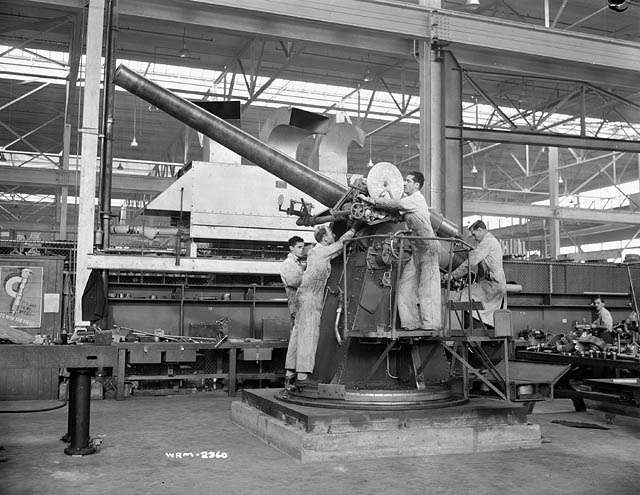
The Vickers-Terni 102 mm/45 S1917 was one of these transnational ventures in artillery, also known as the Schneider-Armstrong and Schneider-Canet. it was derived from the QF 4 inch Mk V naval gun originally and had better performances than the 35 caliber: 2,3 tons (5,130 lb) for 4.7 meters (15 ft 5 in) long, firing a 13.7–16 kgs (30–35 lb) HE shell, same elevation, rate of fire 7 but 850 to 888 m/s (2,910 ft/s), 15 kilometres (9.3 mi) range at +35°.
40mm (2 pdr QF) Vickers AA
The 40 mm/39 (1.575″) Vickers-Terni moldello 1915/1917 installed fore and aft on the forecastle and stern deck next to the main guns were an Italian licenced copy of the 2-pdr or 4 cm/39 (1.575″) QF Mark II, Mark II* and Mark II*C guns. Arrived in 1917, they weighted 550 lbs. (249 kg) including cooling water, and were basically a super-scaled up Vickers/Maxim machine gun, capable of 200 rounds per minute cyclical and 50-75 rounds per minute practical to coold down the barrel, water-cooled. It could fire a HE 2.95 lbs.(1.34 kg) or CP 2.95 lbs. (1.34 kg) round, at 2,000 fps (610 mps), it a barrel life of 5,000 rounds. It stayed in service until replacement by Breda 20 and 37 mm guns.
In 1916, Guglielmo Pepe received two additional 76mm/40 A1916 guns, and in 1917 they were removed after not giving satisfaction. Instead all had in 1917 an additional pair of 40mm/39 V1917.
By 1927 Alessandro Poerio had one 40mm/39 removed.
Torpedo Tube sand Mines
Initially eight tubes, considerable for a ship of this size, but reduced to two 17.7 in twin tubes. These were De Luca 450 mm tubes, 193 caliber, firing an Italian made A110 or A115, 115 kgs (5.28 or 5.23 m) capable of 38 kts at 1000m for the first and between 30 kts at 3000m setting, 36 at 2000 and 41 at 1000m.
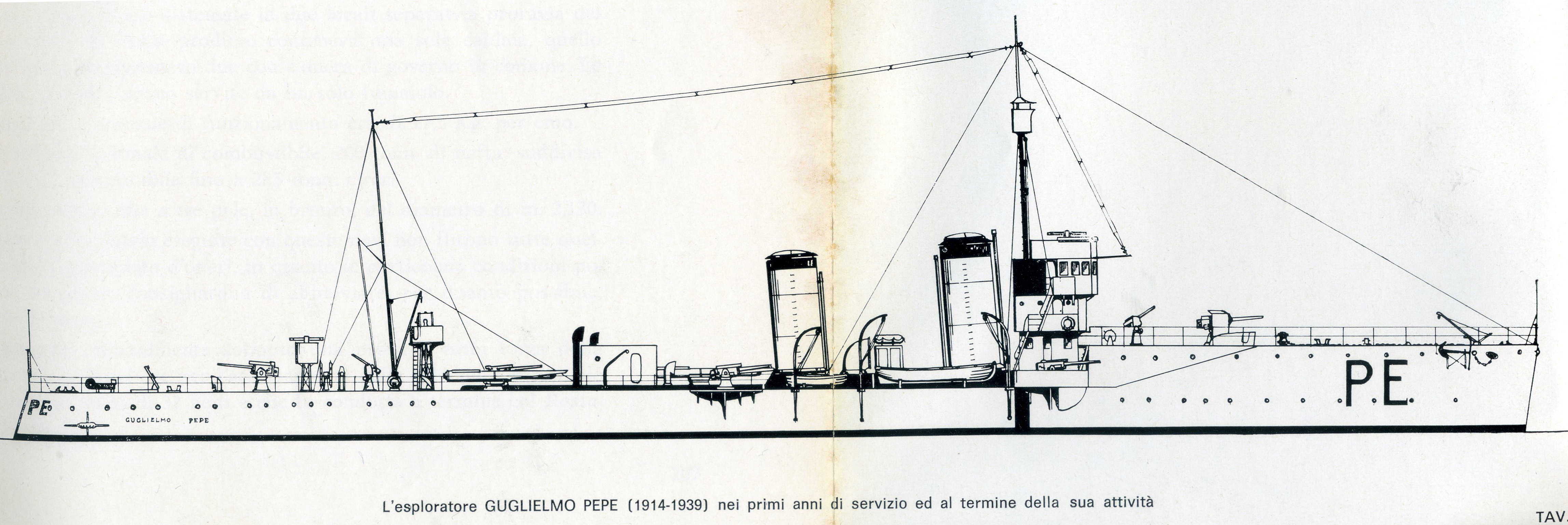
G. pepe at the end of her Italian service, before transfer to Spain.
⚙ Alessandro Poerio class specifications |
|
| Displacement | 891t (standard), 1,216t FL |
| Dimensions | 85 x 8 x 2,8 m |
| Propulsion | 2 shafts Beluzzo steam turbines, 3 Yarrow boilers 24,000 shp |
| Speed | 30 kts |
| Range | 200t oil, 2,415 nautical miles/13 kts |
| Armament | 6x 102 mm/35, 2x 40 mm AA, 2×2 450 mm TTs, 42 mines |
| Protection | Decks 40 mm (1.5 ft) |
| Crew | c190 |
General assessment
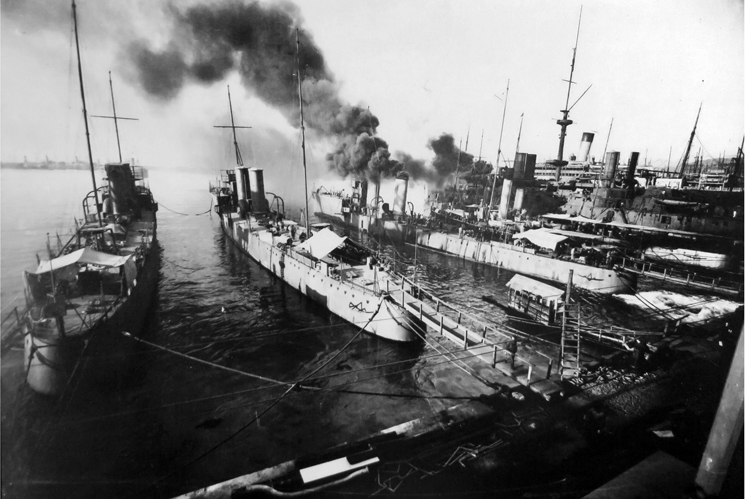
All three destroyers just completed, Genoa 1916 – Coll. Fondation Ansaldo
The Alessandro Poerio class “leggere esploratori” were delivered to the Regia Marina as the war had already begun and they were engaged in operations right off the bat, briefly assigned to the Brindisi base, then IV Division in Venice. They surged in the Adriatic taking part in many interdiction missions but also laid mines and escorted convoys as well as larger ships. Poerio carried out 66 missions and Pepe 64. Rossarol sank on 16 November 1918 after hitting a mine during a transfer from Pola to Fiume, and the war was over, with almost all hands.
The interwar saw the surviving ships changing status from destroyers, and resumed fleet exercises, with frequent missions of representation abroad, notably the Black Sea and Aegean. On 1 July 1921 they acted more as destroyers until decommissioned. Decommissioned in 1937, the were sold to the Spanish Armada, on the Naitonalist side firghting the republicans, part of the help brought to Franco’s faction by the axis. They served with the armada until the early 1950s as Teruel (ex-Pepe ) and Huesca (ex-Poerio) and only stricken from the Regia Marina by January 5, 1939.

Teruel in 1940, coll. Jaume Cifre Sanchez
During the Spanish Civil War, the Nationalist navy also looked for Japan as provider for destroyer and made a list of ten units, delivered in Rome on 26 June 1937, including the cruiser Taranto, destroyers Aquila, Falco, Alessandro Poerio, Guglielmo Pepe, torpedo boats Premuda, Grado and Cortellazzo, two submarines joining General Mola and General Sanjurjo’s forces. The operation allowed the cadree of the Regia Marina on Duce’s orders a source of financing and gathering combat reports. Teruel and Huesca by the time however were worn out and they performed second line duties. They manage to collide with each other again in 1938 during a night exercize. They mosty served as TS after WW2.
 Alessandro Poerio
Alessandro Poerio
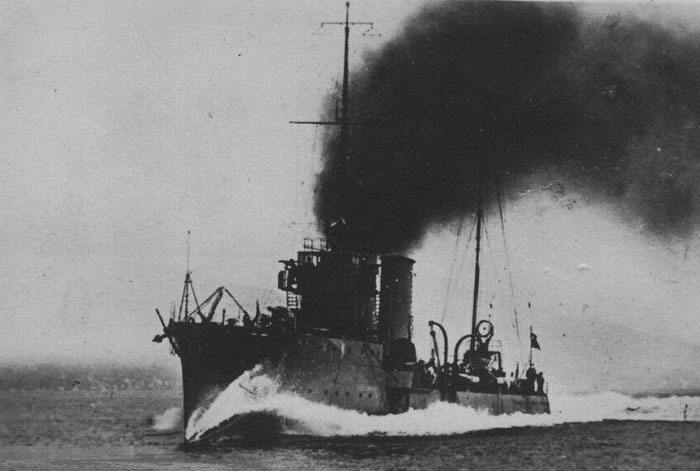
Poerio on sea trials, full speed (Ansaldo coll.)
During the early war, Poerio and her two sisters, operating frm the same unit, were mainly used in “maritime guerrilla” operations, in the Upper Adriatic and later Southern Adriatic as the allies brought additional ships to Brindisi. Peorio carried out 66 combat missions, becoming one of the most active Italian ships in WWI. On December 30, 1915, she was relocated to Venice and formed with her sisters the II Gruppo Esploratori(lg), part of the IV Naval Division. On 1-2 November 1916 Poerio and Pepe, sortied with the destroyers Nullo and Missori, supporting a MAS raid in the Fasana Channel.
In 1917 Poerio was refitted, receiving two 2 Vickers-Terni 40/39 mm m1917 anti-aircraft machine guns and on 19 October 1917 at 6.30, she left Brindisi with Pepe and the destroyers Insidioso, Schiaffino and Bronzetti, in a hot chase against a sortie of the Austro-Hungarian cruiser SMS Helgoland, and the destroyers Lika, Triglav, Tátra, Csepel, Orjen and Balaton out of Cattaro to attack Italian convoys. Helgoland and Lika failed to sight a convoy but were intercepted off Brindisi, lured the Italians to an ambush area were German submarines U 32 and U 40 were posted but the Italians returned to port before arriving there.

A camouflaged Poerio probably in 1918
Later she underwent other modifications and by 10 March 1918 she supported with the Mirabello, Rossarol and Riboty, destroyers Giacinto Carini and Pilade Bronzetti, French destroyer «Casque» a raid by MAS 99 and 100 towed by Nievo and Mosto, on Portorose. Postponed due to bad weather, again on 16 March and on 8 April because aerial reconnaissance proved the port was empty. On 2 October 1918 Poerio escorted Dante Alighieri with Racchia, Rossarol, Pepe, Nievo and Schiaffino to screen her against attacks from Cattaro on the way to bombar Durazzo.
In July 1921 she became a destroyers and started various cruises and representation missions in the Black/Aegean Seas. She had a last overhaul in 1927, and by 1933 she was commanded by frigate captain Ignazio Castrogiovanni. By October 1937, she was sold with Pepe to Nationalist Spanish Navy, becoming Huesca. Before transfer they underwent significant modifications: Their hull was lengthened by one metre (clipper bow), the draft dropped from 3.11 to 2.8 metres by lightening the machinery, with new lighter 5 Yarrow boilers (speed 29 kts) for a standard displacement of 845 standard tons, 911 full load, crew 130 members, one 102mm removed as two 40mm exchanged for modern Breda 37mm and two additional Breda 20mm AA guns.
In May 1938 while escorting merchant ships, Huesca and Teruel accidentally collided but damage was quickly repaired. By the end of August 1938 Huesca intercepted the Spanish republican destroyer José Luis Diaz, trying to pass the Falangist blockade and sail to Gibraltar. On October 17 she captured the motor launch Arsenio Cañada. She was versed to training duty after the war and until decommission, for her in 1953, sold for BU in 1954.
 Cesare Rossarol
Cesare Rossarol

Rossarol entered service close to her sister, and after testing and trials in La Spezia, she was transferred to Taranto. From November 1915 she was assigned to the II Scouts, V Naval Division, southern Adriatic. On December 30, 1915, she was reassigned to Venice with her sisters (II Group, IV Naval Division). On 3 May 1916 under captain Rota she sortied with Pepe, Nullo and Missori for a minelaying operation by Zeffiro and Fuciliere, off Sebenico. While steaming off Punta Maestra they spotted the four Velebit class destroyers leading a pack of six Austro-Hungarian torpedo boats and charged. This transformed into a chase towards Pola, when the Italians were attacked by three seaplanes, and repelled them. By 15.50, heavy ships started to leave Pola to reinforce their chased off ships and the Italian squadron withdrew.
On 11 May Rossarol and Pepe laid a minefield themseves off Ancona. On 12 June they escorted a group some torpedo boats and destroyers Zeffiro, Fuciliere and Alpino (torpedo boats 30 PN and 46 PN), Nullo and Missori in support for the attack of Porec. The night of 25-26 August Rossarol and Pepe escorted MAS 6 and 91 towed by TB 34 PN and 35 PN, to attack steamers at anchor in Durres, but they were already gone. Redeployed to Brindisi, they joined the IV Group of Explorers of the IV Division and started service in the Lower Adriatic.
Overhauled she was back in action on 30 December 1917 and underway from Taranto to Brindisi, spotted and shelled a surfaced U-boat, forced to dive. She escape as her chaser lacked ASW features.
The 10-11 February 1918 night, Rossarol and Pepe, Nievo and Indomito were to carry out another MAS mission but bad weather prevented it. On 10 March 1918 she sortied with Mirabello, Poerio and Riboty, Giacinto Carini and Pilade Bronzetti, French destroyer «Casque» to protect the towed MAS 99 and 100 for an attacked on Portorose, delayed and later cancelled after aerial reconnaissance. On 14-15 May, Rossarol and Pepe coevered MAS 99 and 100 to try penetrate the Antivari roadstead, but they found no targets. By 16 September 1918 she carried troops on the Brindisi-Valona route.

On 2 October 1918 like her sister she escorted Dante Alighieri for a missioned to Cattaro and Durazzo. After Villa Giusti armistice, she was retransferred to the upper Adriatic and entered Pola for anti-submarine patrols. On 10 November with Pepe, she transported occupation troops to Pola. By 16 November 1918, two weeks after the end of the war she was underway from Pola at 11.40 under command of Ludovico De Filippi, to carry to Fiume a Yugoslav officer trying to negociate with Serbian irregulars trying to oppose the Italian occupation of the city. While off Punta Patera as and most of the crew was having lunch, she hit a deriving mine amidships. It blew up close to the dynamo room aft of the bridge, port and the effect was to break her in two. The stern sank first, and prow went on for few hundred metres before sinking in turn, all happening in two minutes. It is still undertain of the pilot, Giovanni Pizzini at the helm led them into an unsignalled minefields. Divers explored it recently.
In total she carried to the bottom 100 men: Commander De Filippi, 6 other officers, XO Ludovico Scaccia Alberti, 93 non-commissioned officers and ratings, and 34 survivors, saved by two MAS and torpedo boat 16 OS. Commander De Filippi was posthumously awarded the Silver Medal for Military Valor while an monument was erected at Punta Munat. She is now resting as a war grave off the coast of Lisignano under 49 metres. The former war reparation destroyer B 97 was named after her. She entered service in 1924.
 Guglielmo Pepe
Guglielmo Pepe

Pepe in the interwar, reclassed as destroyer.
On 30 December 1915 Pepe joined Venice based as the Gruppo II (esp.lg.), IV Naval Division with her sisters. On 3 May 1916 under Commander Capon she sailed with Rossarol and destroyers for a minelaing operation off Šibenik. While Off Punta Maestra they spotted the Velebit class and six TBs, went in hot pursuit until brealing off as reinforcements came our from Pola. By 11 May with Pepe and Rossarol she laid a minefield off Ancona, one 12 June (under Lieutenant Commander Guida) she took part on the mission on Porec. By 1-2 November Pepe and Poerio were scheduled for a MAS raid in the Fasana Channel which never took place. In the night of 25-26 August 1917 she escorted MAS 6 and 91 for an attack on Durres but no transports was found.
On 19 October 1917, she operated under rear-admiral Biscaretti which came on board Poerio. She sailed in hot pursuit with Insidioso, Schiaffino and Bronzetti, to a scout/destroyer flotilla which left Kotor to prey on convoys. The Italans chased them to some point and withdrawn to avoid further air attacks and of submersibles. In 10-11 February 1918 Pepe and Rossarol was assigned another MAS raid, cancelled due to bad weather. On 14-15 May they made an incursion in the Antivari roadstead but found no target. By 2 October 1918 she escorted Dante Alighieri to prevent a bombardment of Durazzo and bu November 10, she carried occupation troops, reinforcements to Pola with Rossarol. By November 27 she landed forces to retake the island of Arbe in Dalmatia.

Teruel in 1937
By July 1921 now a destroyer she multiplied like Poerio cruises and representation missions. By October 1937 she was sold to the Spaniards as Teruel, stricken on 5 January 1939. She was modified prior to transfer like her sister, and during an escort mission collided with her sister, at Palma de Mallorca. She needed 5 months of repairs, her sister three. They were also plagued by machinery issues. She captured the Soviet steamer Zyrianin and US tanker Nantucket Chief. After 1939 she became a training ship, remaining so until 1948, decommissioned and sold for BU.
Read More/Src
Books
Gardiner, Gray, Randal, eds. (1984). Conway’s All the World’s Fighting Ships: 1906–1921.
Motti delle navi Italiane, Roma, Ufficio Storico della Marina Militare, 1998, p. 43.
Cesare Balzi, Dalla prora alla poppa del Rossarol, su Mondo Sommerso – anno 52 – numero 10 (ottobre 2010).
Franco Favre, La Marina nella Grande Guerra. Le operazioni navali, aeree, subacquee e terrestri in Adriatico
R. B. La Racine, In Adriatico subito dopo la Vittoria, su Storia Militare n. 210 – marzo 2011.
Links
archive.is warshipsww2.eu
svahistoria.blogspot.com
diritalia.it
forum.paradoxplaza.com
www.warshipsww2.eu
kbismarck.com/
navypedia.org/
navweaps.com/Weapons/WNBR_2pounder_m2
it.wikipedia.org/wiki/Classe_Alessandro_Poerio
navweaps.com/Weapons/WTIT_List
xray-mag.com
rossarol.krnica.com
marina.difesa.it
balearspotting.com/
Teruel 1937 reddit
todoavante.es
vidamaritima.com



 Latest Facebook Entry -
Latest Facebook Entry -  X(Tweeter) Naval Encyclopedia's deck archive
X(Tweeter) Naval Encyclopedia's deck archive Instagram (@navalencyc)
Instagram (@navalencyc)





 French Navy
French Navy Royal Navy
Royal Navy Russian Navy
Russian Navy Armada Espanola
Armada Espanola Austrian Navy
Austrian Navy K.u.K. Kriegsmarine
K.u.K. Kriegsmarine Dansk Marine
Dansk Marine Nautiko Hellenon
Nautiko Hellenon Koninklije Marine 1870
Koninklije Marine 1870 Marinha do Brasil
Marinha do Brasil Osmanlı Donanması
Osmanlı Donanması Marina Do Peru
Marina Do Peru Marinha do Portugal
Marinha do Portugal Regia Marina 1870
Regia Marina 1870 Nihhon Kaigun 1870
Nihhon Kaigun 1870 Preußische Marine 1870
Preußische Marine 1870 Russkiy Flot 1870
Russkiy Flot 1870 Svenska marinen
Svenska marinen Søværnet
Søværnet Union Navy
Union Navy Confederate Navy
Confederate Navy Armada de Argentina
Armada de Argentina Imperial Chinese Navy
Imperial Chinese Navy Marinha do Portugal
Marinha do Portugal Mexico
Mexico Kaiserliche Marine
Kaiserliche Marine 1898 US Navy
1898 US Navy Sovietskiy Flot
Sovietskiy Flot Royal Canadian Navy
Royal Canadian Navy Royal Australian Navy
Royal Australian Navy RNZN Fleet
RNZN Fleet Chinese Navy 1937
Chinese Navy 1937 Kriegsmarine
Kriegsmarine Chilean Navy
Chilean Navy Danish Navy
Danish Navy Finnish Navy
Finnish Navy Hellenic Navy
Hellenic Navy Polish Navy
Polish Navy Romanian Navy
Romanian Navy Turkish Navy
Turkish Navy Royal Yugoslav Navy
Royal Yugoslav Navy Royal Thai Navy
Royal Thai Navy Minor Navies
Minor Navies Albania
Albania Austria
Austria Belgium
Belgium Columbia
Columbia Costa Rica
Costa Rica Cuba
Cuba Czechoslovakia
Czechoslovakia Dominican Republic
Dominican Republic Haiti
Haiti Hungary
Hungary Honduras
Honduras Estonia
Estonia Iceland
Iceland Eire
Eire Equador
Equador Iran
Iran Iraq
Iraq Latvia
Latvia Liberia
Liberia Lithuania
Lithuania Mandchukuo
Mandchukuo Morocco
Morocco Nicaragua
Nicaragua Persia
Persia San Salvador
San Salvador Sarawak
Sarawak Uruguay
Uruguay Venezuela
Venezuela Zanzibar
Zanzibar Warsaw Pact Navies
Warsaw Pact Navies Bulgaria
Bulgaria Hungary
Hungary

 Bundesmarine
Bundesmarine Dutch Navy
Dutch Navy Hellenic Navy
Hellenic Navy Marina Militare
Marina Militare Yugoslav Navy
Yugoslav Navy Chinese Navy
Chinese Navy Indian Navy
Indian Navy Indonesian Navy
Indonesian Navy JMSDF
JMSDF North Korean Navy
North Korean Navy Pakistani Navy
Pakistani Navy Philippines Navy
Philippines Navy ROKN
ROKN Rep. of Singapore Navy
Rep. of Singapore Navy Taiwanese Navy
Taiwanese Navy IDF Navy
IDF Navy Saudi Navy
Saudi Navy Royal New Zealand Navy
Royal New Zealand Navy Egyptian Navy
Egyptian Navy South African Navy
South African Navy






























 Ukrainian Navy
Ukrainian Navy dbodesign
dbodesign